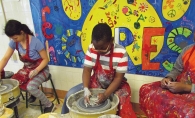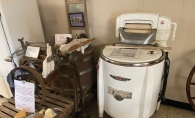
Not so long ago, Maple Grove’s youngsters were well acquainted with rakes, hoes and other garden implements. As neighborhoods have replaced farmsteads and scheduled sports and activities have replaced chores, parents may wonder how to help kids feel a connection to the garden.
Local experts say that the spark for gardening is already in youngsters. Grownups looking to fan the flame should read on for a few simple recommendations.
Make it Their Own
Julie Blue of Elm Creek Elementary, recently named a WCCO-TV “Excellent Educator,” incorporates seed-starting and gardening activities into her first-grade classroom. “First graders have something special that many of us don’t,” Blue explains. “They see everything as a success. It doesn’t have to be beautiful or perfect. It just has to be theirs.” Whether your child is planting bean seeds in a plastic cup, nurturing a pumpkin plant or tending a planter on the deck, be sure to allow leeway for experimentation and ownership. A plant tag, popsicle stick or other marker advertising the child’s name can be an easy and inexpensive way to reinforce a child’s pride in the project.
Make Way for Wonder
A garden offers thousands of “ooh-ahh” moments—opportunities for children and adults to share curiosity and discovery. Blue’s students grow seeds under lights in the classroom each spring. “The first thing the ‘firsties’ [first graders] notice after their seeds are planted in clear plastic cups is that the roots are growing down. A few days later they notice their sprouts are pushing through the surface of the soil.”
Parents and adults can encourage excitement by becoming co-investigators of plants—but also bugs, bees, birds, weeds, weather and more.
Make Connections
Gardening can help kids to connect with others to grow their learning community and social skills. Problem-solving in the garden might take the form of reaching out to a librarian to find a book about garden pests. Tech-savvy kids enjoy capturing photos and videos of flowers and pollinators and sharing them with grandparents and friends. Gardens featuring unique produce such as purple beans or giant sunflowers offer opportunities for unstructured connections between neighborhood kids.
Weaver Lake Elementary connects students to pollinator gardens and prairie habitats as a part of its STEM (science, technology, engineering and math) curriculum. Karla Juetten, curriculum integration coordinator, helps to guide a variety of garden-related activities for students in grades two-five. “Working in the garden enhances our students’ ability to observe their surroundings and increases their sense of wonder about the world,” Juetten says.
“Our fourth graders research plants and each write a letter to me to advocate for the flower they think would best serve pollinators in our garden,” says Juetten, illustrating a great way to help kids feel ownership of garden choices and kinship with garden creatures. “Some choose nectar plants, and some choose plants that serve as good hosts for pollinator larvae, like milkweed for monarch caterpillars.”
Make Time
Gardening activities need not be elaborate, expensive or time consuming. Simple growing activities can be both memorable and meaningful for children as well as for their adults. “We experience together." Blue says. “We make mistakes together, we regroup and try something different.”









